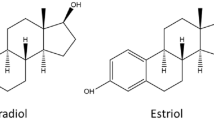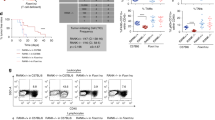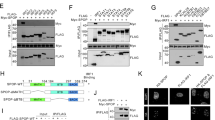Abstract
Estrogens promote cell proliferation and metastases in several human cancers. Here, we describe a different action of estrogens likely to contribute to tumor development-blocking immunosurveillance. In breast cancer cells, increasing concentrations of estrogen induce increasing levels of the granzyme B inhibitor, SerpinB9/proteinase inhibitor 9 (PI-9) and progressively block cell death induced by NK92 natural killer (NK) cells, but do not block killing by a second NK cell line, NKL cells. RNA interference knockdown of PI-9 abolishes estrogen's ability to block NK92 cell-induced cytotoxicity. Expressing elevated levels of estrogen receptor α (ERα) increases the induced level of PI-9, and makes tamoxifen (TAM), but not raloxifene or ICI 182,780, a potent inducer of PI-9. At elevated levels of ERα, induction of PI-9 by estradiol or TAM blocks killing by both NK92 and NKL cells. When the Erk pathway is activated with epidermal growth factor, the concentration of estrogen required to induce a protective level of PI-9 is reduced to 10 pM. Elevated concentrations of estrogen and ER may provide a dual selective advantage to breast cancer cells by controlling PI-9 levels and thereby blocking immunosurveillance. Expressing elevated levels of ERα reveals a potentially important difference in the effects of TAM, raloxifene and ICI 182,780 on immunosurveillance in breast cancer.
This is a preview of subscription content, access via your institution
Access options
Subscribe to this journal
Receive 50 print issues and online access
$259.00 per year
only $5.18 per issue
Buy this article
- Purchase on Springer Link
- Instant access to full article PDF
Prices may be subject to local taxes which are calculated during checkout






Similar content being viewed by others
References
Andrade F, Roy S, Nicholson D, Thornberry N, Rosen A, Casciola-Rosen L . (1998). Granzyme B directly and efficiently cleaves several downstream caspase substrates: implications for CTL-induced apoptosis. Immunity 8: 451–460.
Barrie MB, Stout HW, Abougergi MS, Miller BC, Thiele DL . (2004). Antiviral cytokines induce hepatic expression of the granzyme B inhibitors, proteinase inhibitor 9 and serine proteinase inhibitor 6. J Immunol 172: 6453–6459.
Bird CH, Sutton VR, Sun J, Hirst CE, Novak A, Kumar S et al. (1998). Selective regulation of apoptosis: the cytotoxic lymphocyte serpin proteinase inhibitor 9 protects against granzyme B-mediated apoptosis without perturbing the Fas cell death pathway. Mol Cell Biol 18: 6387–6398.
Blomberg K, Hautala R, Lovgren J, Mukkala VM, Lindqvist C, Akerman K . (1996). Time-resolved fluorometric assay for natural killer activity using target cells labelled with a fluorescence enhancing ligand. J Immunol Methods 193: 199–206.
Bots M, Kolfschoten IG, Bres SA, Rademaker MT, de Roo GM, Kruse M et al. (2005). SPI-CI and SPI-6 cooperate in the protection from effector cell-mediated cytotoxicity. Blood 105: 1153–1161.
Bots M, van Bostelen L, Rademaker MT, Offringa R, Medema JP . (2006a). Serpins prevent granzyme-induced death in a species-specific manner. Immunol Cell Biol 84: 79–86.
Bots M, Offringa R, Medema JP . (2006b). Does the serpin PI-9 protect tumor cells? Blood 107: 4974–4975 (author reply 4975).
Clarke R, Liu MC, Bouker KB, Gu Z, Lee RY, Zhu Y et al. (2003). Antiestrogen resistance in breast cancer and the role of estrogen receptor signaling. Oncogene 22: 7316–7339.
Dunn GP, Old LJ, Schreiber RD . (2004a). The immunobiology of cancer immunosurveillance and immunoediting. Immunity 21: 137–148.
Dunn GP, Old LJ, Schreiber RD . (2004b). The three Es of cancer immunoediting. Annu Rev Immunol 22: 329–360.
Fowler AM, Solodin N, Preisler-Mashek MT, Zhang P, Lee AV, Alarid ET . (2004). Increases in estrogen receptor-alpha concentration in breast cancer cells promote serine 118/104/106-independent AF-1 transactivation and growth in the absence of estrogen. FASEB J 18: 81–93.
Fowler AM, Solodin NM, Valley CC, Alarid ET . (2006). Altered target gene regulation controlled by estrogen receptor-alpha concentration. Mol Endocrinol 20: 291–301.
Godal R, Keilholz U, Uharek L, Letsch A, Asemissen AM, Busse A et al. (2006). Lymphomas are sensitive to perforin-dependent cytotoxic pathways despite expression of PI-9 and overexpression of bcl-2. Blood 107: 3205–3211.
Goping IS, Barry M, Liston P, Sawchuk T, Constantinescu G, Michalak KM et al. (2003). Granzyme B-induced apoptosis requires both direct caspase activation and relief of caspase inhibition. Immunity 18: 355–365.
Gradishar WJ, Cella D . (2006). Selective estrogen receptor modulators and prevention of invasive breast cancer. JAMA 295: 2784–2786.
Gritzapis AD, Baxevanis CN, Missitzis I, Katsanou ES, Alexis MN, Yotis et al. (2003). Quantitative fluorescence cytometric measurement of estrogen and progesterone receptors: correlation with the hormone binding assay. Breast Cancer Res Treat 80: 1–13.
Hupperets PS, Volovics L, Schouten LJ, Jager JJ, Schouten HC, Hillen HF et al. (1997). The prognostic significance of steroid receptor activity in tumor tissues of patients with primary breast cancer. Am J Clin Oncol 20: 546–551.
Jiang X, Orr BA, Kranz DM, Shapiro DJ . (2006). Estrogen induction of the granzyme B inhibitor, proteinase inhibitor 9, protects cells against apoptosis mediated by cytotoxic T lymphocytes and natural killer cells. Endocrinology 147: 1419–1426.
Kanamori H, Krieg S, Mao C, Di Pippo VA, Wang S, Zajchowski DA et al. (2000). Proteinase inhibitor 9, an inhibitor of granzyme B-mediated apoptosis, is a primary estrogen-inducible gene in human liver cells. J Biol Chem 275: 5867–5873.
Kannan-Thulasiraman P, Shapiro DJ . (2002). Modulators of inflammation use nuclear factor-kappa B and activator protein-1 sites to induce the caspase-1 and granzyme B inhibitor, proteinase inhibitor 9. J Biol Chem 277: 41230–41239.
Kataoka T, Shinohara N, Takayama H, Takaku K, Kondo S, Yonehara S et al. (1996). Concanamycin A, a powerful tool for characterization and estimation of contribution of perforin- and Fas-based lytic pathways in cell-mediated cytotoxicity. J Immunol 156: 3678–3686.
Kisanga ER, Gjerde J, Guerrieri-Gonzaga A, Pigatto F, Pesci-Feltri A, Robertson C et al. (2004). Tamoxifen and metabolite concentrations in serum and breast cancer tissue during three dose regimens in a randomized preoperative trial. Clin Cancer Res 10: 2336–2343.
Krieg AJ, Krieg SA, Ahn BS, Shapiro DJ . (2004). Interplay between estrogen response element sequence and ligands controls in vivo binding of estrogen receptor to regulated genes. J Biol Chem 279: 5025–5034.
Krieg SA, Krieg AJ, Shapiro DJ . (2001). A unique downstream estrogen responsive unit mediates estrogen induction of proteinase inhibitor-9, a cellular inhibitor of IL-1beta- converting enzyme (caspase 1). Mol Endocrinol 15: 1971–1982.
Lamboley C, Bringuier AF, Feldmann G . (2000). Apoptotic behaviour of hepatic and extra-hepatic tumor cell lines differs after Fas stimulation. Cell Mol Biol (Noisy-le-grand) 46: 13–28.
Levin ER . (2003). Bidirectional signaling between the estrogen receptor and the epidermal growth factor receptor. Mol Endocrinol 17: 309–317.
Lewis JS, Jordan VC . (2005). Selective estrogen receptor modulators (SERMs): mechanisms of anticarcinogenesis and drug resistance. Mutat Res 591: 247–263.
Lieberman J . (2003). The ABCs of granule-mediated cytotoxicity: new weapons in the arsenal. Nat Rev Immunol 3: 361–370.
Lieberman J, Fan Z . (2003). Nuclear war: the granzyme A-bomb. Curr Opin Immunol 15: 553–559.
Lonning PE, Geisler J, Johannessen DC, Ekse D . (1997). Plasma estrogen suppression with aromatase inhibitors evaluated by a novel, sensitive assay for estrone sulphate. J Steroid Biochem Mol Biol 61: 255–260.
Mahrus S, Craik CS . (2005). Selective chemical functional probes of granzymes A and B reveal granzyme B is a major effector of natural killer cell-mediated lysis of target cells. Chem Biol 12: 567–577.
Mahrus S, Kisiel W, Craik CS . (2004). Granzyme M is a regulatory protease that inactivates proteinase inhibitor 9, an endogenous inhibitor of granzyme B. J Biol Chem 279: 54275–54282.
Medema JP, de Jong J, Peltenburg LT, Verdegaal EM, Gorter A, Bres SA et al. (2001). Blockade of the granzyme B/perforin pathway through overexpression of the serine protease inhibitor PI-9/SPI-6 constitutes a mechanism for immune escape by tumors. Proc Natl Acad Sci USA 98: 11515–11520.
Meldrum DR, Davidson BJ, Tataryn IV, Judd HL . (1981). Changes in circulating steroids with aging in postmenopausal women. Obstet Gynecol 57: 624–628.
Phillips T, Opferman JT, Shah R, Liu N, Froelich CJ, Ashton-Rickardt PG . (2004). A role for the granzyme B inhibitor serine protease inhibitor 6 in CD8+ memory cell homeostasis. J Immunol 173: 3801–3809.
Riera J, Simpson JF, Tamayo R, Battifora H . (1999). Use of cultured cells as a control for quantitative immunocytochemical analysis of estrogen receptor in breast cancer. The Quicgel method. Am J Clin Pathol 111: 329–335.
Romain S, Chinot O, Guirou O, Soulliere M, Martin PM . (1994). Biological heterogeneity of ER-positive breast cancers in the post-menopausal population. Int J Cancer 59: 17–19.
Russell JH, Ley TJ . (2002). Lymphocyte-mediated cytotoxicity. Annu Rev Immunol 20: 323–370.
Sancho-Garnier H, Delarue JC, Mouriesse H, Contesso G, May-Levin F, Gotteland M et al. (1995). Is the negative prognostic value of high oestrogen receptor (ER) levels in postmenopausal breast cancer patients due to a modified ER gene product? Eur J Cancer 31A: 1851–1855.
Sebbagh M, Hamelin J, Bertoglio J, Solary E, Breard J . (2005). Direct cleavage of ROCK II by granzyme B induces target cell membrane blebbing in a caspase-independent manner. J Exp Med 201: 465–471.
Smith IE, Dowsett M . (2003). Aromatase inhibitors in breast cancer. N Engl J Med 348: 2431–2442.
ten Berge RL, Oudejans JJ, Ossenkoppele GJ, Meijer CJ . (2003). ALK-negative systemic anaplastic large cell lymphoma: differential diagnostic and prognostic aspects – a review. J Pathol 200: 4–15.
Thomas DA, Du C, Xu M, Wang X, Ley TJ . (2000). DFF45/ICAD can be directly processed by granzyme B during the induction of apoptosis. Immunity 12: 621–632.
Thorpe SM, Christensen IJ, Rasmussen BB, Rose C . (1993). Short recurrence-free survival associated with high oestrogen receptor levels in the natural history of postmenopausal, primary breast cancer. Eur J Cancer 29A: 971–977.
van Houdt I, Oudejans JJ, van den Eertwegh AJ, Baars A, Vos W, Bladergroen BA et al. (2005). Expression of the apoptosis inhibitor protease inhibitor 9 predicts clinical outcome in vaccinated patients with stage III and IV melanoma. Clin Cancer Res 11: 6400–6407.
Vogel VG, Costantino JP, Wickerham DL, Cronin WM, Cecchini RS, Atkins JN et al. (2006). Effects of tamoxifen vs raloxifene on the risk of developing invasive breast cancer and other disease outcomes: the NSABP Study of Tamoxifen and Raloxifene (STAR) P-2 trial. JAMA 295: 2727–2741.
Yager JD, Davidson NE . (2006). Estrogen carcinogenesis in breast cancer. N Engl J Med 354: 270–282.
Zhang M, Park SM, Wang Y, Shah R, Liu N, Murmann AE et al. (2006). Serine protease inhibitor 6 protects cytotoxic T cells from self-inflicted injury by ensuring the integrity of cytotoxic granules. Immunity 24: 451–461.
Acknowledgements
We are grateful to Dr J Miller, Dr M Robertson and Dr C Froelich who generously provided the NK92, NKL and YT cell lines, respectively. Grant Support: NIH DK071909 and HD16720 (to DS) and DOD BCRF W81XH-04-1-0327 and NIH DK64034 (to EA).
Author information
Authors and Affiliations
Corresponding author
Additional information
Supplementary Information accompanies the paper on the Oncogene website (http://www.nature.com/onc).
Supplementary information
Rights and permissions
About this article
Cite this article
Jiang, X., Ellison, S., Alarid, E. et al. Interplay between the levels of estrogen and estrogen receptor controls the level of the granzyme inhibitor, proteinase inhibitor 9 and susceptibility to immune surveillance by natural killer cells. Oncogene 26, 4106–4114 (2007). https://doi.org/10.1038/sj.onc.1210197
Received:
Revised:
Accepted:
Published:
Issue Date:
DOI: https://doi.org/10.1038/sj.onc.1210197
Keywords
This article is cited by
-
The immunomodulatory effects of endocrine therapy in breast cancer
Journal of Experimental & Clinical Cancer Research (2021)
-
Tumour-infiltrating lymphocytes and response to neoadjuvant letrozole in patients with early oestrogen receptor-positive breast cancer: analysis from a nationwide phase II DBCG trial
Breast Cancer Research (2020)
-
CD56+ immune cell infiltration and MICA are decreased in breast lobules with fibrocystic changes
Breast Cancer Research and Treatment (2018)
-
Clinical significance of tumor-infiltrating lymphocytes in breast cancer
Journal for ImmunoTherapy of Cancer (2016)
-
Graft microvascular disease in solid organ transplantation
Journal of Molecular Medicine (2014)



